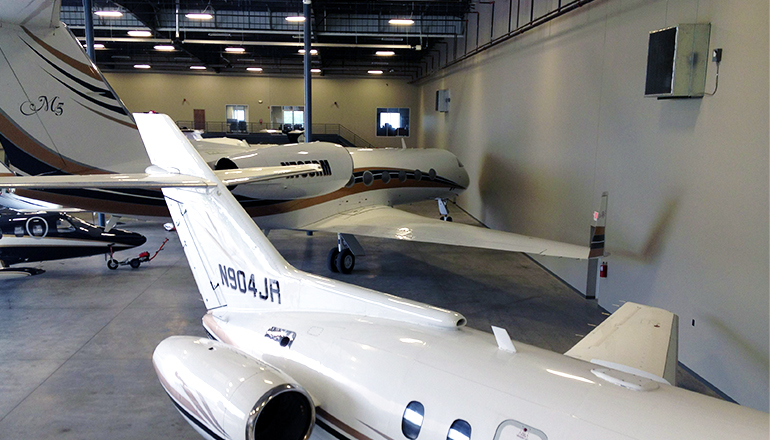From the second we step out of bed in the morning, we are surrounded by technology. Having a “smart home” quickly becomes the norm rather than the exception.
The Internet of Things (IoT) has evolved to the point where every home is easily interconnected in ways that high-end industrial facilities could only dream of a few short years ago. So, if a home can become a symbiotic digital organism, what about an airplane hangar? Airplane hangars are a natural place to employ smart technologies to continuously monitor environmental conditions, employ security features, and even conduct pre-flight routines like pre-heating engines, warming up the hangar, etc. In addition, the hangar itself is a host of smart maintenance tools in more radical applications.
What Is A Smart Hangar?
So, what is a smart hangar? The first thing we need to determine is whether or not it is only new construction that can be smart or if owners can modify old construction to employ smart technologies.
The short answer is that both can be correct. For example, if a new hangar is constructed, it makes perfect sense to have smart technologies built into the new construction; the added cost of these technologies to the existing construction cost is relatively minimal, as opposed to adding on the tech later.
However, there is no reason to think that an existing hangar can’t benefit from technological improvements regardless of age. However, we need to think of airplane hangars as more than two-dimensional. Hangars are versatile facilities that may be used strictly for aircraft storage, storage, aircraft maintenance, or dedicated maintenance facilities (MRO), depending on organizational demands.
But basically, a smart hangar is just that: it is a hangar that is digitally tailored to make the task of the hangar easier, better, or more efficient.
Storage Hangars
Storage hangars are reserved primarily for general aviation aircraft and private jets. Commercial aircraft are seldom stored indoors, and when they are stored indoors, it is almost always for maintenance checks and inspections. Otherwise, they are in the air or parked on an apron.
Adapting or modifying a storage hangar for relatively small aircraft is not simple, but it is a different animal than the demands of a maintenance check hangar.
The primary objective with private aircraft hangars is to preserve the aircraft finish and systems, keep it somewhat climate-controlled, and keep the aircraft secure. In other words, the smart additions to a storage hangar are more along the lines of a smart home or office. These will include internal and external video monitoring, security systems not unlike those installed on residential homes, remote environmental controls, and perhaps even an aircraft preheater installed and a remote door opener.
These items certainly make a life for the pilot more convenient, but they are essentially just that: matters of convenience. However, smart MRO facilities are entirely in a different league, poised to revolutionize heavy aircraft maintenance.
MRO Hangars
Smart MRO hangars are the wave of the future. They will completely revolutionize how aircraft maintenance occurs by making the hangar a component of aircraft maintenance.
How, you may ask, will a building become part of the maintenance process? It isn’t the structure itself that becomes part of the process but the technology the building will be equipped with.
Drones
There is no part of the aviation industry, and perhaps even all of the industrial maintenance, that is not being directly impacted by the use and application of drones in aircraft inspections.
The reason for this is simple. Drones removed much of the human element from the error chain. Inspections are time-intensive and labor-intensive, and it is all too easy to miss an essential item over the entire skin of a passenger airliner, which amounts to many hundreds or thousands of square feet.
It is next to impossible to view the entire skin of an airliner without missing a square foot, especially the backbone, the vertical stabilizer, and the top side of the empennage control surfaces. If technicians are going to inspect those areas, it will require powered lifts, safety harnesses, and a lot of manhours.
On the other hand, drones require no such safety equipment. Also, a drone can be preprogrammed with a flight path tailored precisely to the airframe in question. It will take high-resolution video and still pictures of the entire surface, including the highest parts. A single operator can inspect the entire surface in an hour or two. As the years' progress, drones may be able to initiate the process and conduct the entire inspection process autonomously upon the aircraft entering the hangar. After every flight, a programmed drone can inspect the entire jet surface for smaller private jets.
Additive Manufacturing
Additive manufacturing, known colloquially as 3D printing, may not seem like a pivotal part of an intelligent hangar, but let’s take a step back and think about its capability. Additive manufacturing will allow MROs to print select parts on demand.
This will obviously work because the OEM might create the files with the exact specifications and sell them to each MRO. Then, as soon as the item is found to be damaged, the MRO techs can put a request in the printer queue for the part to be printed.
This isn’t some far-fetched idea or theory; Boeing is actively using 3D printed technology to print parts on their 787 Dreamliner jets. We may see maintenance become autonomous to the point where the feed from a drone or robotic inspection will be analyzed using AI and can trigger a part being printed.
Secure Ledgers
It bears repeating: recording maintenance transactions throughout the lifecycle of the part or aircraft increases the overall safety. Maintenance ledgers have traditionally been paper-based ordeals. The aircraft maintenance history can amount to tens of thousands of pages per aircraft. These records are hard to keep and maintain throughout the lifespan of an airplane.
Secure ledger technology, namely Blockchain, creates an immutable transaction ledger for the aircraft's entire lifetime, which permanently maintains every historical maintenance action on the aircraft. So, for example, when an overhauled engine is purchased, there is no question about what happens.
Automatic Guided Vehicles
Perhaps the cornerstone of the smart hangar is the ground support equipment. If you think about it, the entire purpose of a smart hangar is to reduce the burden on manpower, and few things demand more manpower than aircraft ground movement.
Automatic guided vehicles (AGVs) are the solution to smart hangars of all sizes that operators are looking for. AGVs can be programmed for any number of movement patterns. As long as there is no equipment outside of designated areas, the AGV will move aircraft to predetermined locations with no human interface.
AGV technology is a viable option for both operation hangars and MRO hangars. Whether fixed-wing or rotary-wing, the aircraft can be moved into and out of a hangar on command in an operations hangar. The hangar doors can be automated and opened remotely, and an AGV on predestined routes can take the aircraft to the apron entirely autonomously.
In an MRO environment, AGVs have a multitude of uses. For one, they can fetch aircraft to bring into the maintenance docks. Since the tug can only operate on predestined routes, there is no longer any need for wing and tail walkers during the movements. The aircraft will move exactly on the programmed route and will stop at the same position every single time. This will save enormous amounts of time in the long run since docks and maintenance stands can largely stay in position.
Also, multiple AGVs can be synched together, which allows compound and complex movements of the aircraft which can even include lateral movements. Or, a pair of AGVs can be synched for movements through a manufacturing hangar to move wings, fuselages, and other large items through tight areas that require great precision.
In Closing
Technology is transforming the way aircraft ground operations are conducted. We see it in all areas, but perhaps little more than aircraft maintenance and ground support equipment. Maintaining a secure ledger of activities in maintenance has long been a struggle, yet Blockchain is poised to revolutionize the process. Towing aircraft has always been labor-intensive, but now AGVs are about to change all of that by requiring no personnel for aircraft ground movement. These technologies will be fully integrated with a number of other emerging technologies to create hangar environments that are much safer, intuitive, and far more efficient than was previously thought possible.
If you are ready to see AGVs can add to your smart hangar ecosystem, contact Mototok today to set up a consultation!



Comments